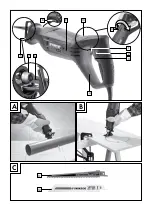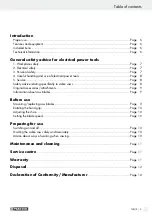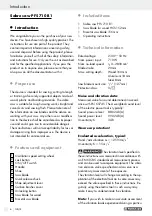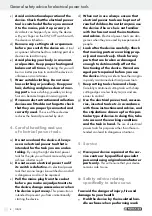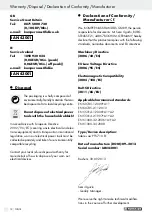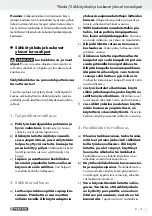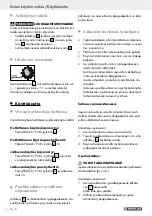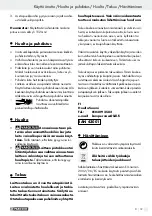
9
GB/IE
where there is danger of the tool used
striking hidden electrical lines or its
own power cable.
Contact with a live wire
could cause metal parts of the device to be-
come live and lead to electric shock.
If you use the device outdoors, always connect
it through a residual current device (RCD) with
a maximum trip current of 30 mA.
Securely support the workpiece. Use clamps or
a vice to grip the workpiece firmly. This is much
safer than holding it in your hand.
Never support yourself by placing your hands
near or in front of the device or the workpiece
surface. A slip can result in injury.
If a dangerous situation arises, pull the mains
plug immediately out of the mains socket.
Always work with the mains lead leading away
from the rear of the device.
DANGER oF FIRE FRoM FLyING SPARKS!
Sawing metal creates flying sparks.
For this reason, always make sure that nobody
is placed in any danger and that there are no
inflammable materials near the working area.
NoxIoUS FUMES!
Working
with harmful / noxious dusts represents a risk to
the health of the person operating the device
and to anyone near the work area.
Wear protective glasses and a dust mask!
Do not saw materials containing asbestos.
Asbestos is a known carcinogen.
When sawing building materials, observe the
statutory requirements and the manufacturer’s
recommendations.
Do not work on moist materials or damp surfaces.
Switch the device on before you bring it into
contact with the workpiece.
CAUTIoN!
Do not allow the blade to come
into contact with a solid object or the floor when
the device is operating – danger of kickback!
The shoe
5
must always lie against the work-
piece when the device is sawing.
Do not put the device down before it has been
switched off and has reached a standstill.
Use only sharp, defect-free blades. Replace
cracked, bent or blunt saw blades immediately.
Always keep the device clean, dry and free of
oil or grease.
Q
original accessories /
attachments
Use only the accessories detailed in
the operating instructions.
The use of in-
serted tools or accessories other than those
recommended in the operating instructions
could lead to you suffering an injury.
Q
Information about saw blades
You can use any saw blade as long as it has the
correct shank fitting -
1
/
2
“ (12.7 mm) universal shaft.
There are different saw blades available in various
lengths designed to ensure optimum performance
of every sawing task with your sabre saw.
Note:
TPI = teeth per inch / (i.e. per 2.54 cm)
Blade (wood)
11
:
Dimensions: 152 x 1.25 mm, 6 TPI
Most suitable for: Sawing construction timber,
chipboard, processed wood boards, plywood.
Also suitable for plunge cuts.
Bi-metal saw blade
12
:
Dimensions: 156 mm, 18 TPI
Most suitable for: Sawing sheets, profiles and tubes
– flexible and fracture resistant.
Q
Before use
Q
Mounting / replacing
saw blades
Pull the mains plug out of the
mains socket before you carry out any task on the de-
vice. Failure to observe this advice may lead to injury.
Turn the quick-release chuck
7
and hold it in
the turned position.
Press the selected saw blade up to the stop
into the quick-release chuck
7
. The saw blade
should engage.
Release the quick-release chuck
7
. The chuck
must then return to its original position. The saw
blade is now locked in place.
General safety advice for electrical power tools / Before use
General safety advice for electrical power tools
Summary of Contents for 43001
Page 3: ...A B C 11 12 10 4 9 7 6 5 1 3 2 10 8...
Page 4: ......
Page 46: ...46...
Page 56: ...56...



